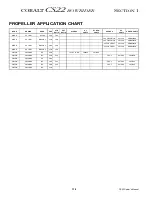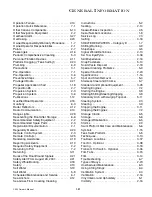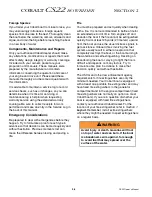
CS22 Owner’s Manual
2
-
9
R
ESPONSIBILITIES
AND
S
AFETY
1 – Recharge
2 – Overcharge
Be sure to:
• Use caution and do not smoke when refueling.
• Verify that fuel does not leak.
• Use only marine approved equipment on your
boat.
Flooding/Swamping
Improper loading, handling, water conditions,
weather and anchoring are the most common
causes of flooding. Insist on a safe, stable load. Do
not operate the boat exceeding your ability to
maneuver it. Use extreme caution in hazardous
weather and rough water conditions. Anchor from
the bow when using one anchor.
Collisions/Leaks
If a collision occurs, immediately account for all
passengers. Assess the hull for damage and
activate the bilge pumps to reduce any water
intake. Try to operate the boat to keep the damaged
area above water. If necessary, call or signal for
assistance. If a leak is discovered, immediately
determine the cause. A collision with an underwater
object could cause the hull to develop a leak. A
loose fitting or hose clamp on a piece of equipment
could cause a leak. Try to repair the leak if possible.
If a leak is threatening the safety of you and your
passengers, call or signal for assistance.
Operating in Shallow Water
• Shallow water presents obvious hazards
including insufficient water depth, sand bars,
stumps, or other unmarked obstructions.
• Other hazards in shallow water include mud,
sand, weeds, rocks, logs and debris. These
hazards can damage your boat hull or
underwater gear and can foul your engine
cooling water intakes, which could cause
overheating.
• Know the area in which you are operating.
Consult charts and ask local boaters. If you
know or suspect shallow water, post a lookout
and proceed slowly.
• When beaching, be aware how tide can affect
the boat. Never leave a beached boat
unattended or unanchored.
Grounding
In the event you run aground, assess the situation
before proceeding. Immediately stop any water
from entering the boat. Inspect the propulsion
unit(s), steering and control systems, and the hull
for damage. Maneuver the boat to safe water only if
the hull and all operating systems are in
satisfactory operating condition. Otherwise, call or
signal for assistance.
Storms
Take common sense precautions if you are forced
to operate your boat in stormy conditions.
• Wear personal flotation devices (PFDs).
• Stow gear below deck and batten down
equipment on deck.
• Reduce speed and head for a safe place that
you can easily reach.
KC-0083C
2
1
A
WARNING
COLLISION HAZARD – Use extra
caution in shallow water or where
underwater/floating objects may be
present. Hitting an object at high speed
or severe angle can seriously injure
people and damage your boat.
Summary of Contents for CS22
Page 2: ...ii CS22 Owner s Manual COBAL T CS22 BOWRIDER ...
Page 8: ...viii CS22 Owner s Manual COBAL T CS22 BOWRIDER NOTES ...
Page 60: ...2 30 CS22 Owner s Manual COBAL T CS22 BOWRIDER SECTION 2 NOTES ...
Page 102: ...4 4 CS22 Owner s Manual COBAL T CS22 BOWRIDER SECTION 4 ...
Page 124: ...6 10 CS22 Owner s Manual COBAL T CS22 BOWRIDER SECTION 6 NOTES ...
Page 132: ...7 8 CS22 Owner s Manual COBAL T CS22 BOWRIDER SECTION 7 NOTES ...
















































